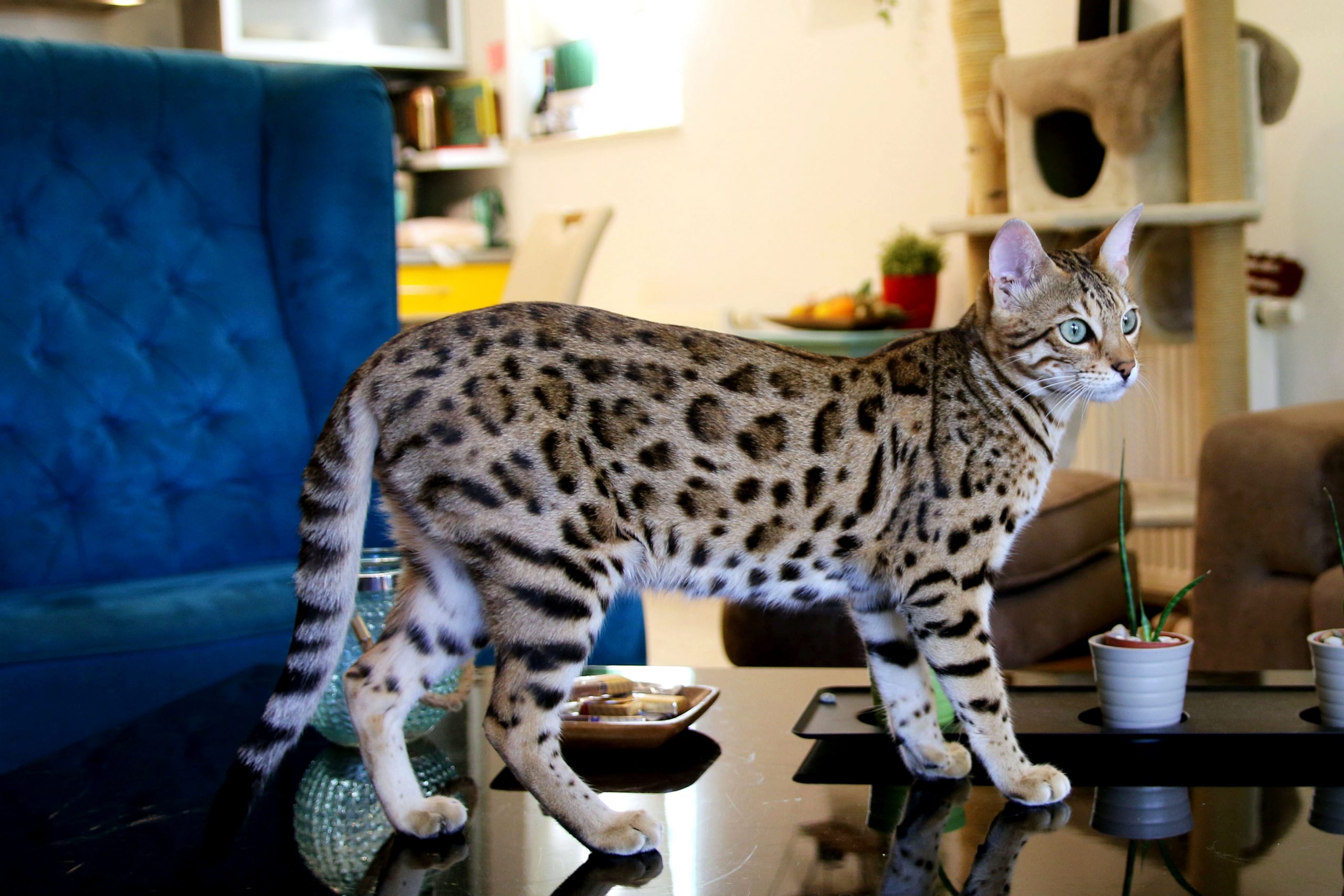If you love a cat with an exotic look but without the size and danger of a wild cat, the Bengal was developed with you in mind. Created by crossing small Asian Leopard Cats with domestic cats, this large-boned, shorthaired cat stands out for his spotted or marbled coat of many colors.
Don’t get a Bengal if what you’re looking for is a sweet, gentle lap cat or a living sculpture that requires little interaction. The intelligent, curious Bengal is highly active. Constantly on the move, he loves climbing to high places, enjoys playing fetch and going for walks on leash, and thrives best when he has access to a large outdoor enclosure where he can indulge in the favorite feline hobby of bird-watching.
Some Bengals are fond of playing in water, and you may find yours fishing out of the aquarium if you’re not careful. This is a happy, entertaining cat who wants lots of attention. He does best with a person who spends a lot of time at home and will enjoy playing and interacting with him.
The short coat is easy to groom with weekly brushing. Trim the nails as needed.
Other Quick Facts
- The Bengal’s beautiful coat comes in many background colors, ranging from golden, rust, brown and orange to sand, buff and ivory. Bengal spots also vary in color, from rust or cocoa and chocolate brown to charcoal or black.
- Some Bengal coats have striking rosettes or spots made up of more than one color, usually a secondary color forming a dark outlining to the spot. Bengal coats also come in a marbled pattern: one or more colors swirled into the background color. While most commonly seen in the brown spotted tabby pattern, they may also be found in the marbled pattern (classic tabby).
- A Bengal’s coat can have hairs with an iridescent sheen, making it look as if it has been sprinkled with glitter.
History of the Bengal
 People have always been attracted by the beauty and independence of wild cats and have even tried to keep wild cats such as ocelots, cheetahs and lions, usually with little success and a lot of heartbreak. The Bengal was developed to try to meet that desire for a wild look in a safe way by crossing small wild Asian Leopard Cats and domestic shorthairs. Jean S. Mill began the Bengal breeding program in 1963, and Bengals today descend from cats bred by her in the early 1980s.
People have always been attracted by the beauty and independence of wild cats and have even tried to keep wild cats such as ocelots, cheetahs and lions, usually with little success and a lot of heartbreak. The Bengal was developed to try to meet that desire for a wild look in a safe way by crossing small wild Asian Leopard Cats and domestic shorthairs. Jean S. Mill began the Bengal breeding program in 1963, and Bengals today descend from cats bred by her in the early 1980s.
The International Cat Association recognized Bengals in 1991. The breed is not recognized by the Cat Fanciers Association.
Bengal Temperament and Personality
Bengals are a lot of fun to live with, but they’re definitely not the cat for everyone, or for first-time cat owners. Extremely intelligent, curious and active, they demand a lot of interaction and woe betide the owner who doesn’t provide it. If you won’t be home during the day to entertain your Bengal, plan to have two of them or don’t get one. When a Bengal gets bored, he is capable of taking things apart to see how they work and opening drawers and cabinets to see what interesting toys or food might be available for him.
The Bengal loves his people and will do anything for attention from them. If he figures out that you don’t like something he does — jumping on the kitchen counter, for instance — he will start doing it all the time because it will get your attention and force you to interact with him. He also likes to take things and hide them. Put your jewelry away in a place where he can’t get it (you hope).
Every cat is an individual, but most Bengals get along with other pets, including dogs. They are best suited to homes with older children who will enjoy playing with them, but as long as they have an escape route from toddlers they should do well with them.
This is a cat who needs a lot of vertical territory. Bengals love to climb, the higher the better. Provide them with tall cat trees and window perches. They are also fond of playing water. Don’t be surprised if your Bengal wants to join you in the shower or bathtub. You may find yourself installing a motion-sensitive faucet in your bathroom or kitchen so he can turn the water on and off for himself. If that’s not on your agenda, he will appreciate having a pet fountain to drink from.
They are also highly intelligent and enjoy the attention that comes with being clicker-trained. Challenge their brain and keep them interested in life by teaching them tricks and games and providing them with interactive toys or puzzle toys that will reward them with kibble or treats when they learn how to manipulate them.
Always choose a kitten from a breeder who raises litters in the home and handles them from an early age. Meet at least one and ideally both of the parents to ensure that they have nice temperaments.
What You Need To Know About Bengal Health
 All cats have the potential to develop genetic health problems, just as all people have the potential to inherit diseases. Any breeder who claims that her breed has no health or genetic problems is either lying or is not knowledgeable about the breed. Run, don’t walk, from any breeder who does not offer a health guarantee on kittens, who tells you that the breed is 100 percent healthy and has no known problems, or who tells you that her kittens are isolated from the main part of the household for health reasons.
All cats have the potential to develop genetic health problems, just as all people have the potential to inherit diseases. Any breeder who claims that her breed has no health or genetic problems is either lying or is not knowledgeable about the breed. Run, don’t walk, from any breeder who does not offer a health guarantee on kittens, who tells you that the breed is 100 percent healthy and has no known problems, or who tells you that her kittens are isolated from the main part of the household for health reasons.
Bengals have hereditary health issues that can be a concern, especially if you aren’t cautious about who you buy from. One possible condition is polycystic kidney disease, but DNA tests are now available to help remove affected cats from the breeding pool. Bengals may also be more prone to some infectious diseases such as feline infectious peritonitis and trichimonas foetus, a protozoal infection that causes diarrhea. Responsible breeders take steps to identify or avoid these problems.
Remember that after you’ve taken a new kitten into your home, you have the power to protect him from one of the most common health problems: obesity. Keeping a Bengal at an appropriate weight is one of the easiest ways to protect his overall health. Make the most of your preventive abilities to help ensure a healthier cat for life.
The Basics of Bengal Grooming
Bengals have a short, luxurious, soft coat that is easy to care for with weekly brushing. He will love the attention, and if you brush him more often you will find fewer dust bunnies and hairballs around the house.
The rest is basic care. Trim the nails as needed, usually weekly. Check the ears every week for redness or a bad smell that could indicate an infection. If the ears look dirty, wipe them out with a cotton ball dampened with a gentle cleanser recommended by your veterinarian. Brush his teeth frequently at home with a vet-approved pet toothpaste and schedule veterinary cleanings as needed. Start brushing, nail trimming and teeth brushing early so your kitten becomes accepting of this activity.
Choosing a Bengal Breeder
It’s not the easiest decision and can take some work to find someone you feel totally comfortable with, but it’s well worth the effort!
- The breeder will be your ongoing support system.
When questions come up, the breeder is there for you and your kitten. - Your kitten’s most influential development period is with the breeder!
Its time with the breeder is the foundation for the rest of its life. - It’s important to support ethical breeding practices by choosing a reputable breeder.
An ethical breeder is someone who prioritizes the physical and emotional health of their cats, and does not sacrifice their cats’ well-being for profit.
Things to consider when looking for a breeder
First, make these 5 checks:
- Do you like the breeder’s adult cats?
Instead of immediately looking for kitten photos, you’ll want to look at the adults! This will give you a better idea of what the kittens will look like when they grow up. - At what age does the breeder let kittens go home?
Studies show that kittens should stay with their mother until they’re 12-16 weeks old. If the breeder is letting kittens go home before they’re 10 weeks, don’t work with them. - Do they perform standard health testing?
Find out what health tests the breeder performs. Make sure they’re testing for HCM, PK-def, and PRA. - Do they offer a health guarantee and contract?
Do they have a contract and health guarantee in place? - Are they registered?
Do they indicate anywhere on their site that they are a registered cattery? You may see a TICA or CFA logo, but to ensure the cats are purebred and the breeder has breeding rights, you’ll want to look for the adult’s pedigrees.
Then, take a closer look at the breeders you’re considering:
- Is there a buyer screening process in place?
Good breeders really care where their kittens go. Look for an application or questionnaire. A “Buy Now” button is not good. - What’s included with a kitten?
Make sure they’re vaccinating and deworming kittens before sending them home. Do they include neutering, microchipping, or anything extra? If this is important to you, make a note. - Look at their photos.
Do the cats seem to be kept in good housing conditions? - Do they allow visitors?
You’ll likely want to meet the parents of the kittens and see the cattery for yourself. If the breeder specifies that they don’t allow visits, discuss with them the option of live video sharing. - Does the breeder come across as knowledgeable and helpful?
By now, you probably have a sense of one or two breeders who would be your top pick! Reach out to them via their preferred method (often a kitten questionnaire or website contact form).
Once you’ve shared some communication and you feel comfortable with your breeder of choice, they’ll let you know your next steps. They may add you to their waitlist, or if kittens are available, you can schedule a visit and make a deposit.
Also, take a look at: Best Toys For Bengal Cats







